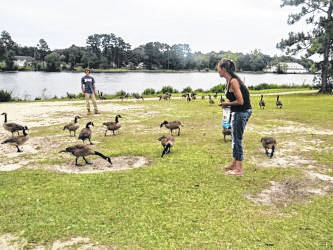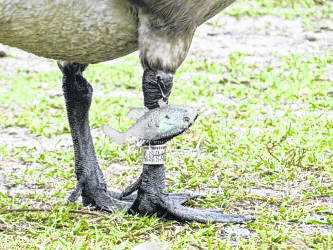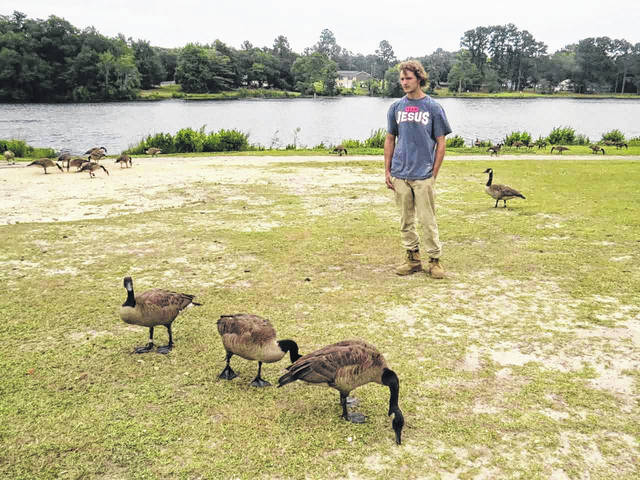HAMLET — A group of geese that hang out around the old VFW building near City Lake have fallen on hard times.
Several harbor infections that have created holes in their webbed feet, and one can’t escape the fishing line wrapped around its leg — with the lure still hanging off and the hook lodged in the goose’s skin.
The Canada geese also recently hatched some chicks and have been crossing Boyds Lake Road daily, putting their broods at greater risk for being hit by cars.
Angela Aldridge, whose son, Matthew, works near the lake, said the two had buried five or six young geese during the past week.
When Aldridge — who gleaned basic medical knowledge from her mother, a nurse — realized that not only were the geese in danger but that they wore bands on their legs, indicating that someone was tracking them, she began to call state and local wildlife agencies, zoos and sanctuaries to find someone to help the birds. She had no luck.
“It’s a shame some organization took the time to band them but can’t take care of them,” Aldridge said. “To me, that’s animal cruelty.”
Even though she sees about 20 people a day feed the geese — herself included — Aldridge said that many residents didn’t seem to have respect for the birds.
Matthew Aldridge even said he saw someone stop for the geese as they crossed the road. But when they didn’t move after the driver honked the horn, the driver hit the gas and ran over the geese.
On Thursday, a staff member at the North Carolina Zoo in Asheboro gave Aldridge the numbers of several people who might help. When Aldridge called, one suggested she get an Uber driver to take the injured geese to Carolina Waterfowl Rescue in Indian Trail, since Aldridge can’t travel that far herself — or at least, not that far with geese in her truck.
On Friday, Rupert Medford, district wildlife biologist with the N.C. Wildlife Commission, said that although the commission’s was not responsible for to treating wild creatures as if they were pets, taking care of every health problem they encounter, the commission would respond to specific cases when asked and do what it could for animals they encountered while performing their duties.
“Putting a mark on something doesn’t declare ownership,” Medford said. “Wildlife are owned by the public trust. They belong to everybody — not the people whose land they’re on, not who studies them.”
As it turns out, the geese were marked as part of a study between the commission and N.C. State University to compare methods of estimating goose populations: a new aerial-photography method vs. the older mark-and-recapture method, Medford said.
Marking the geese helps researches learn a great deal about the birds, he said, but acknowledged concern that the markings could make people think the birds belonged to someone.
Hunters who report the unique numbers on each marked bird they kill are the main way the commission and other researchers track populations. Canada geese are fair game for permit bearers.
“We know how many (bands) we put out, and we know how many we get back, so we can learn about the population,” Medford said.
The geese at the Hamlet lake were marked about about two years ago, he said.
For those concerned about the birds’ being hurt when they are marked, Medford said the process took place after molting, so the birds didn’t move very much and were fairly easy to round up.
He advised that it’s neither healthy nor safe to feed the geese because it encourages them to stay in an area, which can create a nuisance.
Aldridge and her son spent Friday morning and afternoon trying to capture the goose with the hook in its leg, so they could help it or take it somewhere who could, but to no avail.
Medford said fishing line could cause lifelong injuries — or, possibly, amputation — but that most geese survived such snares.
“It’s unfortunate,” he said. “That sort of thing happens, and critters do get run over.”



